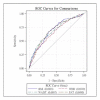The relationship of high sensitivity C-reactive protein to percent body fat mass, body mass index, waist-to-hip ratio, and waist circumference in a Taiwanese population
- PMID: 20875142
- PMCID: PMC2956725
- DOI: 10.1186/1471-2458-10-579
The relationship of high sensitivity C-reactive protein to percent body fat mass, body mass index, waist-to-hip ratio, and waist circumference in a Taiwanese population
Abstract
Background: High-sensitivity C-reactive protein (hs-CRP) is an easily measured inflammatory biomarker. This study compared the association of percent body fat mass (%FM), body mass index (BMI), waist circumference (WC), and waist-to-hip ratio (WHR) with hs-CRP in a Taiwanese population.
Methods: A total of 1669 subjects aged 40-88 years were recruited in 2004 in a metropolitan city in Taiwan. The relationships between obesity indicators and a high level of hs-CRP were examined using multivariate logistic regression analysis. The upper quartile of the hs-CRP distributions was defined as the high category group. The areas under the curve (AUCs) of the receiver operating characteristic curves were calculated for all obesity indicators to compare their relative ability to correctly classify subjects with a high level of hs-CRP.
Results: After multivariate adjustment, the odds ratio for %FM was the only significant indicator that was associated with a high level of hs-CRP in men (1.55, 95% CI: 1.07-2.25). All indicators were associated with a high level of hs-CRP in women. In men, the AUCs for %FM were significantly higher than those for BMI, WHR, and WC, when demographic and lifestyle behaviors were considered (p < 0.001 for all comparisons), but they were not significantly different in females.
Conclusions: Our study demonstrates that %FM is the only obesity indicator that is strongly associated with a high level of hs-CRP after adjusting for sociodemographic factors, lifestyle behaviors and components of metabolic syndrome in both genders in a Taiwanese population aged forty years and over. In men, %FM had the greatest ability to classify subjects with a high level of hs-CRP when only demographic and lifestyle behaviors were considered. Our study finding has important implications for the screening of obesity in community settings.
Figures
Similar articles
-
Ability of adiposity indicators to identify elevated high-sensitivity C-reactive protein in young adults.Nutrition. 2019 Jul-Aug;63-64:75-80. doi: 10.1016/j.nut.2018.11.025. Epub 2018 Nov 24. Nutrition. 2019. PMID: 30933729
-
Sex difference of the predictive value of BMI, waist circumference and percentage body fat mass for gallstone disease.Br J Nutr. 2019 Apr;121(8):955-960. doi: 10.1017/S000711451900028X. Epub 2019 Feb 11. Br J Nutr. 2019. PMID: 30739620
-
The discriminative ability of waist circumference, body mass index and waist-to-hip ratio in identifying metabolic syndrome: Variations by age, sex and race.Diabetes Metab Syndr. 2015 Apr-Jun;9(2):74-8. doi: 10.1016/j.dsx.2015.02.006. Epub 2015 Mar 6. Diabetes Metab Syndr. 2015. PMID: 25819369
-
[Relationship between serum high-sensitivity C-reactive protein and obesity and impaired glycose metabolism in children and adolescents].Zhonghua Er Ke Za Zhi. 2006 Dec;44(12):933-6. Zhonghua Er Ke Za Zhi. 2006. PMID: 17254464 Chinese.
-
The association of plasma C-reactive protein levels with anthropometric and lipid parameters in elderly Taiwanese.Asia Pac J Clin Nutr. 2008;17(4):651-6. Asia Pac J Clin Nutr. 2008. PMID: 19114404
Cited by
-
Psychiatric symptoms are not associated with circulating CRP concentrations after controlling for medical, social, and demographic factors.Transl Psychiatry. 2022 Jul 12;12(1):279. doi: 10.1038/s41398-022-02049-y. Transl Psychiatry. 2022. PMID: 35821205 Free PMC article.
-
Sick fat: the good and the bad of old and new circulating markers of adipose tissue inflammation.J Endocrinol Invest. 2019 Nov;42(11):1257-1272. doi: 10.1007/s40618-019-01052-3. Epub 2019 May 9. J Endocrinol Invest. 2019. PMID: 31073969 Review.
-
Association of dietary patterns, anthropometric measurements, and metabolic parameters with C-reactive protein and neutrophil-to-lymphocyte ratio in middle-aged and older adults with metabolic syndrome in Taiwan: a cross-sectional study.Nutr J. 2018 Nov 19;17(1):106. doi: 10.1186/s12937-018-0417-z. Nutr J. 2018. PMID: 30454030 Free PMC article.
-
Thyroid Hormones and Cardiometabolic Risk Factors in Saudi Women with Polycystic Ovary Syndrome: A Cross-Sectional Study.Int J Womens Health. 2023 Jul 26;15:1197-1203. doi: 10.2147/IJWH.S405942. eCollection 2023. Int J Womens Health. 2023. PMID: 37525744 Free PMC article.
-
Body composition, C-reactive protein, carotid artery remodeling and subclinical atherosclerosis in a general Taiwanese population.J Thromb Thrombolysis. 2012 Feb;33(2):185-92. doi: 10.1007/s11239-011-0669-3. J Thromb Thrombolysis. 2012. PMID: 22205174
References
-
- Kannel WB, D'Agostino RB, Cobb JL. Effect of weight on cardiovascular disease. Am J Clin Nutr. 1996;63(Suppl 4):19–22. - PubMed
-
- Alberti KG, Zimmet PZ. Definition, diagnosis and classification of diabetes mellitus and its complications. Part 1: diagnosis and classification of diabetes mellitus provisional report of a WHO consultation. Diabet Med. 1998;15:539–553. doi: 10.1002/(SICI)1096-9136(199807)15:7<539::AID-DIA668>3.0.CO;2-S. - DOI - PubMed
-
- WHO. Obesity: Preventing and managing the global epidemic. Geneva: WHO; 1998. - PubMed
-
- Kuczmarki RJ, Flegal KM, Campbell SM, Johnson CL. Increasing prevalence of overweight among US adults. The National Health and Nutrition Examination Surveys, 1960 to 1991. JAMA. 1998;22:39–47. - PubMed
Publication types
MeSH terms
Substances
LinkOut - more resources
Full Text Sources
Research Materials
Miscellaneous



